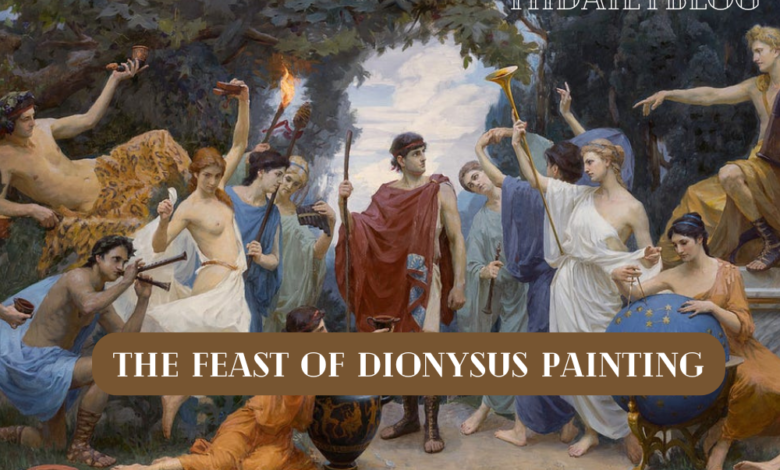The Feast of Dionysus Painting A Celebration of Myth, Art, and Revelry

The Feast of Dionysus painting is a captivating subject that bridges ancient Greek mythology with vibrant artistic interpretations. Dionysus, the Greek god of wine, festivity, and theater, has been a prominent figure in art for centuries. Paintings depicting Dionysus and his feast capture the energy, vitality, and chaos associated with the god and his revelers.
History of Dionysus and His Celebrations
Who Is Dionysus?
Dionysus, also known as Bacchus in Roman mythology, is one of the twelve Olympian gods. He is the god of wine, pleasure, fertility, and festivity. In ancient Greece, Dionysus was worshiped through festivals known as “Dionysia,” which included ritualistic drinking, performances, and ecstatic dances. These festivals were believed to bring participants closer to the divine.
Dionysus was not just a god of chaos but also one who symbolized the cyclical nature of life and death, fertility, and rebirth. The Feast of Dionysus was an important event that celebrated the dual nature of life: joy and sorrow, excess and moderation.
The Role of the Feast in Greek Culture
The Feast of Dionysus, known as Dionysia, was one of the most important festivals in ancient Greece. It involved processions, theatrical performances, music, and, of course, wine. These celebrations inspired numerous works of art, including paintings that captured the lively, energetic scenes of Dionysus and his followers.
Theatrical performances, often tragedies and comedies, were a central part of these festivals. It was during the Dionysia that playwrights like Sophocles, Aeschylus, and Euripides would debut their works, making the festival crucial not only to Greek religious life but also to the development of theater and art.
The Feast of Dionysus in Art
The Themes of the Feast in Paintings
Paintings inspired by the Feast of Dionysus often depict a mix of wild celebration, nature, and mythology. These works capture the revelry of the feast, complete with Dionysus, satyrs, and maenads (female followers of Dionysus) partaking in wine and dance. The visual representation of these mythological figures offers artists the opportunity to explore the boundaries of human emotion, from ecstatic joy to frenzied madness.
Artistic Interpretations
Over the centuries, various artists have portrayed the Feast of Dionysus with different stylistic approaches. Some artists focus on the chaotic and ecstatic nature of the feast, painting scenes of dancing, drinking, and wild behavior. Others may emphasize the god’s connection to nature, using imagery of vines, animals, and lush landscapes to symbolize fertility and life.
One of the most famous works depicting Dionysian themes is The Triumph of Bacchus by Diego Velázquez, where Bacchus is seen crowning a reveler with a garland. This Renaissance painting captures the juxtaposition of mortal joy with divine ecstasy, illustrating the allure of Dionysus’ domain.
In other interpretations, the Feast of Dionysus painting explores darker themes of madness and loss, which reflect the duality of the god’s influence on humanity. These works, often more somber in tone, remind viewers of the fine line between celebration and destruction.
Also Read: Sylvester Stallone Net Worth 2024: A Detailed Breakdown of His Wealth and Career
Why the Feast of Dionysus Painting Endures
Symbolism in Dionysian Paintings
The enduring appeal of the Feast of Dionysus painting lies in its rich symbolism. Dionysus represents more than just wine and parties; he embodies the full spectrum of human emotions. In paintings, his feast can symbolize both the liberation that comes from embracing joy and the potential danger of excess.
Moreover, the interplay between nature, myth, and humanity creates a visual and emotional complexity that artists and viewers alike find fascinating. The chaos of the feast reflects the unpredictable nature of life, while the joy of the participants underscores the importance of living in the moment.
Modern Interpretations and Popularity
In contemporary art, the Feast of Dionysus painting continues to inspire. Artists are drawn to the dynamic and colorful depictions of the god’s celebrations. The festival’s connection to both theater and visual art makes it a rich source of creative inspiration, whether in classical forms or modern reinterpretations.
FAQs
What Is the Significance of the Feast of Dionysus in Greek Art?
The Feast of Dionysus is significant in Greek art because it symbolizes the connection between the divine and the human, the sacred and the profane. Dionysus’ role as a god of both fertility and chaos makes him an intriguing figure for artists, leading to numerous depictions of his feast in both classical and modern works.
Which Artists Are Known for Depicting Dionysian Themes?
Several artists have depicted Dionysian themes in their work, including Caravaggio, Titian, and Velázquez. These artists were drawn to the dynamic and emotional energy of the Feast of Dionysus painting, each bringing their unique interpretation to the theme.
What Are the Common Elements in a Feast of Dionysus Painting?
Common elements in a Feast of Dionysus painting include Dionysus himself, surrounded by his followers (often satyrs and maenads), wine, music, and revelry. Many paintings also include lush natural settings, symbolizing the god’s connection to fertility and life.
Is the Feast of Dionysus Only Depicted in Paintings?
While the Feast of Dionysus painting is one of the most common artistic representations, the feast is also depicted in sculptures, mosaics, and even theater. The festival’s connection to the arts makes it a popular subject across various forms of creative expression.
Conclusion
The Feast of Dionysus painting is a timeless representation of humanity’s complex relationship with joy, nature, and excess. Whether depicted in classical or contemporary styles, the themes of Dionysian revelry continue to captivate artists and viewers alike. With its rich symbolism and vibrant energy, this subject remains a beloved inspiration in the world of art.





